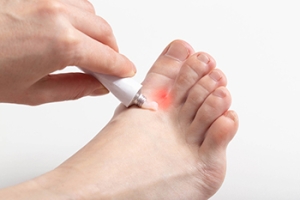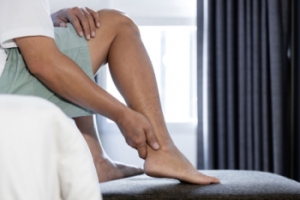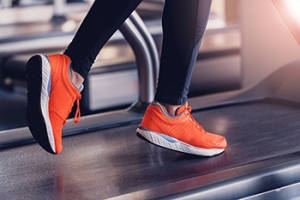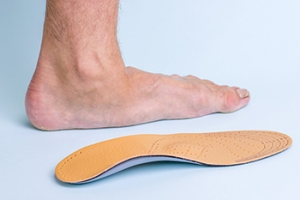Connect With Us
Blog

What Is Athlete’s Foot?
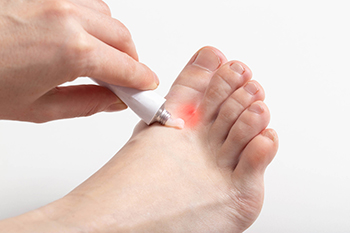 Athlete's foot is a fungal infection that affects the skin of the feet. It's caused by various types of fungi that thrive in warm, moist environments. Athlete’s foot is commonly contracted in places such as locker rooms, swimming pools, and communal showers. When the feet are exposed to these fungi, they can easily penetrate the skin, leading to the development of athlete's foot. Factors such as wearing tight or poorly ventilated shoes, sweating excessively, or having a weakened immune system can increase the risk of developing athlete’s foot. Athlete’s foot is highly contagious and can spread through direct contact with infected skin or by sharing contaminated items like towels or shoes. Symptoms of athlete's foot include itching, redness, and peeling of the skin between the toes or on the soles of the feet. Podiatrists, or foot doctors, are well-equipped to diagnose and treat athlete's foot. They may offer treatments, such as antifungal medications and topical treatments to help patients find relief. If you suspect athlete’s foot, it is suggested that you consult a podiatrist for prompt treatment.
Athlete's foot is a fungal infection that affects the skin of the feet. It's caused by various types of fungi that thrive in warm, moist environments. Athlete’s foot is commonly contracted in places such as locker rooms, swimming pools, and communal showers. When the feet are exposed to these fungi, they can easily penetrate the skin, leading to the development of athlete's foot. Factors such as wearing tight or poorly ventilated shoes, sweating excessively, or having a weakened immune system can increase the risk of developing athlete’s foot. Athlete’s foot is highly contagious and can spread through direct contact with infected skin or by sharing contaminated items like towels or shoes. Symptoms of athlete's foot include itching, redness, and peeling of the skin between the toes or on the soles of the feet. Podiatrists, or foot doctors, are well-equipped to diagnose and treat athlete's foot. They may offer treatments, such as antifungal medications and topical treatments to help patients find relief. If you suspect athlete’s foot, it is suggested that you consult a podiatrist for prompt treatment.
Athlete’s Foot
Athlete’s foot is often an uncomfortable condition to experience. Thankfully, podiatrists specialize in treating athlete’s foot and offer the best treatment options. If you have any questions about athlete’s foot, consult with one of our podiatrists from Lakeside Foot and Ankle Center. Our practitioners will assess your condition and provide you with quality treatment.
What Is Athlete’s Foot?
Tinea pedis, more commonly known as athlete’s foot, is a non-serious and common fungal infection of the foot. Athlete’s foot is contagious and can be contracted by touching someone who has it or infected surfaces. The most common places contaminated by it are public showers, locker rooms, and swimming pools. Once contracted, it grows on feet that are left inside moist, dark, and warm shoes and socks.
Prevention
The most effective ways to prevent athlete’s foot include:
- Thoroughly washing and drying feet
- Avoid going barefoot in locker rooms and public showers
- Using shower shoes in public showers
- Wearing socks that allow the feet to breathe
- Changing socks and shoes frequently if you sweat a lot
Symptoms
Athlete’s foot initially occurs as a rash between the toes. However, if left undiagnosed, it can spread to the sides and bottom of the feet, toenails, and if touched by hand, the hands themselves. Symptoms include:
- Redness
- Burning
- Itching
- Scaly and peeling skin
Diagnosis and Treatment
Diagnosis is quick and easy. Skin samples will be taken and either viewed under a microscope or sent to a lab for testing. Sometimes, a podiatrist can diagnose it based on simply looking at it. Once confirmed, treatment options include oral and topical antifungal medications.
If you have any questions, please feel free to contact our offices located in Leesburg and The Villages, FL . We offer the newest diagnostic and treatment technologies for all your foot care needs.
Athlete's Foot
Athlete’s foot is an extremely contagious infection caused by a fungus that results in itching, burning, dry, and flaking feet. The fungus that causes athlete’s foot is known as tinea pedis and thrives in moist, dark areas such as shower floors, gyms, socks and shoes, commons areas, public changing areas, bathrooms, dormitory style houses, locker rooms, and public swimming pools. Athlete’s foot is difficult to treat as well because of the highly contagious and recurrent nature of the fungus.
Tinea is the same fungus that causes ringworm, and is spread by direct contact with an infected body part, contaminated clothing, or by touching other objects and body parts that have been exposed to the fungus. Because the feet are an ideal place for tinea to grow and spread, this is the most commonly affected area. It is, however, known to grow in other places. The term athlete’s foot describes tinea that grows strictly on the feet.
The most commonly infected body parts are the hands, groin, and scalp, as well as the feet. Around 70% of the population suffer from tinea infections at some point in their lives, however not all of these cases are athlete’s foot. Just like any other ailment, some people are more likely to get it than others, such as people with a history of tinea infections or other skin infections, both recurring and non-recurring ones. The extent to which a person experiences regrowth and recurrent tinea infections varies from person to person.
Sometimes people will not even know that they are infected with tinea or that they have athlete’s foot because of a lack of symptoms. However, most experience mild to moderate flaking, itching, redness, and burning. However, some of the more severe symptoms include cracking and bleeding skin, intense itching and burning, pain while walking or standing, and even blistering.
Because of the recurring nature of the tinea fungus and the athlete’s foot it causes, the best way to treat this condition is with prevention. You can take some preventative measures such as wearing flip flops or sandals in locker rooms and public showers to reduce contact with the floor. It also helps to keep clean, dry feet while allowing them to breathe. Using powders to keep your feet dry is a good idea, as well as keeping your feet exposed to light and cool air, to prevent the growth of tinea. If you do happen to get athlete’s foot, opt for using topical medicated creams, ointments or sprays. These treatments help eliminate and prevent it from coming back.
Various Types of Achilles Tendon Injuries
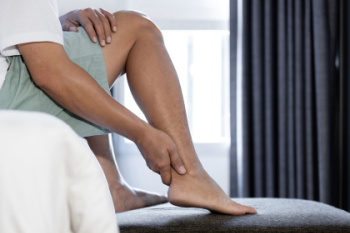
Achilles tendon injuries encompass various conditions affecting the Achilles tendon, the large tendon connecting the calf muscles to the heel bone. Tendonitis involves inflammation of the tendon due to overuse or repetitive stress, causing pain and swelling along the back of the lower leg or above the heel. Tendinosis refers to chronic degeneration of the Achilles tendon, often resulting from untreated or recurrent tendonitis. This condition may manifest as persistent pain and stiffness in the affected area. Paratenonitis affects the outer layer of the tendon, causing pain and swelling around the tendon rather than within it. Insertional Achilles tendinitis occurs at the point where the tendon inserts into the heel bone, leading to pain, swelling, and sometimes the formation of a bony bump. Treatment may involve rest, anti-inflammatory medications, custom-made orthotic devices, and in severe cases, surgical intervention to repair or remove damaged tissue. If you suffer from Achilles pain, it is suggested that you schedule an appointment with a podiatrist for a treatment plan tailored to your condition and the severity of the injury.
Achilles tendon injuries need immediate attention to avoid future complications. If you have any concerns, contact one of our podiatrists of Lakeside Foot and Ankle Center. Our practitioners can provide the care you need to keep you pain-free and on your feet.
What Is the Achilles Tendon?
The Achilles tendon is a tendon that connects the lower leg muscles and calf to the heel of the foot. It is the strongest tendon in the human body and is essential for making movement possible. Because this tendon is such an integral part of the body, any injuries to it can create immense difficulties and should immediately be presented to a doctor.
What Are the Symptoms of an Achilles Tendon Injury?
There are various types of injuries that can affect the Achilles tendon. The two most common injuries are Achilles tendinitis and ruptures of the tendon.
Achilles Tendinitis Symptoms
- Inflammation
- Dull to severe pain
- Increased blood flow to the tendon
- Thickening of the tendon
Rupture Symptoms
- Extreme pain and swelling in the foot
- Total immobility
Treatment and Prevention
Achilles tendon injuries are diagnosed by a thorough physical evaluation, which can include an MRI. Treatment involves rest, physical therapy, and in some cases, surgery. However, various preventative measures can be taken to avoid these injuries, such as:
- Thorough stretching of the tendon before and after exercise
- Strengthening exercises like calf raises, squats, leg curls, leg extensions, leg raises, lunges, and leg presses
If you have any questions please feel free to contact our offices located in Leesburg and The Villages, FL . We offer the newest diagnostic tools and technology to treat your foot and ankle needs.
What are Achilles Tendon Injuries
The Achilles tendon is the strongest tendon in the human body. Its purpose is to connect the lower leg muscles and calf to the heel of the foot. This tendon is responsible for facilitating all types of movement, like walking and running. This tendon provides an enormous amount of mobility for the body. Any injuries inflicted to this tissue should be immediately brought up with a physician to prevent further damage.
The most common injuries that can trouble the Achilles tendon are tendon ruptures and Achilles tendinitis. Achilles tendinitis is the milder of the two injuries. It can be recognized by the following symptoms: inflammation, dull-to-severe pain, increased blood flow to the tendon, thickening of the tendon, and slower movement time. Tendinitis can be treated via several methods and is often diagnosed by an MRI.
An Achilles tendon rupture is trickier to heal, and is by far the most painful injury. It is caused by the tendon ripping or completely snapping. The results are immediate and absolutely devastating, and will render the patient immobile. If a rupture or tear occurs, operative and non-operative methods are available. Once the treatment begins, depending on the severity of the injury, recovery time for these types of issues can take up to a year.
Simple preventative measures can be taken as a means to avoid both injuries. Prior to any movement, taking a few minutes to stretch out the tendon is a great way to stimulate the tissue. Calf raises, squats, leg curls, leg extensions, leg raises, lunges, and leg presses are all suggested ways to help strengthen the lower legs and promote Achilles tendon health.
Many problems arise among athletes and people who overexert themselves while exercising. Problems can also happen among those who do not warm up properly before beginning an activity. Proper, comfortable shoes that fit correctly can also decrease tendon injuries. Some professionals also suggest that when exercising, you should make sure that the floor you are on is cushioned or has a mat. This will relieve pressure on the heels. A healthy diet will also increase tendon health.
It is very important to seek out a podiatrist if you believe you have an injury in the Achilles region. Further damage could result in severe complications that would make being mobile difficult, if not impossible.
Considerations for Choosing Running Shoes
 Selecting the right running shoe involves considering several factors to ensure optimal support, comfort, and injury prevention. The first is your foot type, such as flat feet, high arches, or normal arches. You may also have a certain gait pattern, which is how your foot moves when you walk or run. Some people have feet that roll to the outside or inside, and certain shoes address this. Another consideration in choosing running shoes is the type of running you'll be doing. The right shoe should provide adequate cushioning to absorb impact, support tailored to your foot's arch type, and a comfortable fit for natural foot movement. Podiatrists can help you to understand all of the factors in this selection process. With their expertise in foot mechanics and conditions, podiatrists can perform a comprehensive evaluation of your feet to recommend shoes that match your needs. For example, they can conduct a gait analysis to recommend the right shoes for the way you walk. They can also identify any underlying issues that might affect your choice, such as pronation concerns or the need for custom orthotics. If you are in the market for new running shoes, it is suggested that you consult a podiatrist to find shoes that will maintain your foot health and optimize your running performance.
Selecting the right running shoe involves considering several factors to ensure optimal support, comfort, and injury prevention. The first is your foot type, such as flat feet, high arches, or normal arches. You may also have a certain gait pattern, which is how your foot moves when you walk or run. Some people have feet that roll to the outside or inside, and certain shoes address this. Another consideration in choosing running shoes is the type of running you'll be doing. The right shoe should provide adequate cushioning to absorb impact, support tailored to your foot's arch type, and a comfortable fit for natural foot movement. Podiatrists can help you to understand all of the factors in this selection process. With their expertise in foot mechanics and conditions, podiatrists can perform a comprehensive evaluation of your feet to recommend shoes that match your needs. For example, they can conduct a gait analysis to recommend the right shoes for the way you walk. They can also identify any underlying issues that might affect your choice, such as pronation concerns or the need for custom orthotics. If you are in the market for new running shoes, it is suggested that you consult a podiatrist to find shoes that will maintain your foot health and optimize your running performance.
You should always make sure your running shoes fit properly in order to avoid injury. For more information, contact one of our podiatrists from Lakeside Foot and Ankle Center. Our practitioners can provide the care you need to keep you pain-free and on your feet.
Choosing the Right Running Shoe for Your Foot Type
Improper shoe sizing can cause a myriad of problems for your feet. Shoes that don’t fit you properly can lead to muscular imbalances in your body, which can result in foot, knee, and hip injuries.
Tips for Finding the Right Running Shoe
- Make sure you have a thumb’s width of wiggle room between the end of your longest toe and the front of the shoe.
- There should be little to no slipping at the heel
- Don’t assume your size in one shoe brand will be your size in another
- Do not lace up your shoes too tightly
- Walk around in the store with your new shoes before you buy them
If you have any questions please feel free to contact our our offices located in Leesburg and The Villages, FL . We offer the newest diagnostic and treatment technologies for all your foot and ankle needs.
Choosing the Right Running Shoe
Choosing the right running shoes for you is an important part of running. A good pair of running shoes will make the running experience more enjoyable for you and prevent potential injury.
Poorly-fitted shoes can increase the risk of injury in runners substantially. Common injuries from running with poor quality shoes include shin splints, sprained ankles, Achilles tendinitis, stress fractures, plantar fasciitis and more. This is due to the fact that bad shoes do not provide proper foot support, can increase pronation (how much the foot rolls when hitting the ground), have little to no cushioning, do not allow the feet to breath, and do not provide enough flex and rigidity in the right parts.
When looking for running shoes, first, determine where you will be running. If you are a trail runner, then pick trail shoes. If you run on concrete and asphalt, then regular running shoes are the best choice. When trying on shoes, its best to go at the end of the day as feet grow during the day and shrink after a night of sleep. Shoes should be more rigid towards the back of the foot while being more flexible up where the toes are. The toe box should provide enough room for the toes to move freely. The overall fit should be snug, not too tight but not too loose. A good pair of running shoes should also provide enough arch support for your foot type. If you experience overpronation or under-pronation while running, try to find a pair of shoes that will help correct this with different sole patterns. Finally, try to find a pair of shoes that allow the feet to breathe like nylon mesh or synthetic leather.
Don’t forget about the socks either. Socks that hold too much moisture can lead to athlete’s foot. Socks should be breathable so that your feet can air out and breathe. Synthetic socks wick away moisture like sweat. If you tend to run a lot, having a second pair of shoes that you can wear while you let the first pair air out is smart. Just don’t forget to replace your shoes after about every 300 to 500 miles.
Before you start running, it is advised to see a podiatrist to see if running is right for you. They can also offer good advice on how to run and what to look for in a pair of running shoes. If you have flat feet or poorly supported ones, they can also offer custom-made orthotics that will help give your feet the support they need.
Complications From Blisters on the Feet
 Blisters on the feet, though seemingly minor, can lead to more serious complications if not treated properly. These small pockets of fluid form as a result of friction or pressure, commonly from wearing ill-fitting shoes or increased physical activity. While they often heal on their own, blisters can become infected. Infections are indicated by increased pain, redness, swelling, or the presence of pus. It is important to seek medical attention if there are signs of infection, which can escalate into cellulitis, a deeper, more serious skin infection that can spread quickly. For individuals with diabetes or compromised immune systems, the risk of complications from foot blisters is significantly higher. These conditions can impair blood circulation and wound healing, making even small blisters potential gateways to severe infections. If you have a blister that is showing signs of infection, especially if a blister is not healing as expected, it is suggested that you schedule an appointment with a podiatrist as quickly as possible.
Blisters on the feet, though seemingly minor, can lead to more serious complications if not treated properly. These small pockets of fluid form as a result of friction or pressure, commonly from wearing ill-fitting shoes or increased physical activity. While they often heal on their own, blisters can become infected. Infections are indicated by increased pain, redness, swelling, or the presence of pus. It is important to seek medical attention if there are signs of infection, which can escalate into cellulitis, a deeper, more serious skin infection that can spread quickly. For individuals with diabetes or compromised immune systems, the risk of complications from foot blisters is significantly higher. These conditions can impair blood circulation and wound healing, making even small blisters potential gateways to severe infections. If you have a blister that is showing signs of infection, especially if a blister is not healing as expected, it is suggested that you schedule an appointment with a podiatrist as quickly as possible.
Blisters may appear as a single bubble or in a cluster. They can cause a lot of pain and may be filled with pus, blood, or watery serum. If your feet are hurting, contact one of our podiatrists of Lakeside Foot and Ankle Center. Our practitioners can provide the care you need to keep you pain-free and on your feet.
Foot Blisters
Foot blisters are often the result of friction. This happens due to the constant rubbing from shoes, which can lead to pain.
What Are Foot Blisters?
A foot blister is a small fluid-filled pocket that forms on the upper-most layer of the skin. Blisters are filled with clear fluid and can lead to blood drainage or pus if the area becomes infected.
Symptoms
(Blister symptoms may vary depending on what is causing them)
- Bubble of skin filled with fluid
- Redness
- Moderate to severe pain
- Itching
Prevention & Treatment
In order to prevent blisters, you should be sure to wear comfortable shoes with socks that cushion your feet and absorb sweat. Breaking a blister open may increase your chances of developing an infection. However, if your blister breaks, you should wash the area with soap and water immediately and then apply a bandage to the affected area. If your blisters cause severe pain it is important that you call your podiatrist right away.
If you have any questions, please feel free to contact our offices located in Leesburg and The Villages, FL . We offer the newest diagnostic and treatment technologies for all your foot care needs.
Blisters
Blisters are pockets of fluid that occur under the top layer of your skin. These fluid pockets are usually filled with pus, blood, or serum. Blisters may itch or hurt and can appear as a single bubble or in clusters.
The most common types of blisters are friction blisters. This type of blister may be caused by wearing shoes that are too tight. Friction blisters can also occur on the hands. A change in temperature may also cause blisters on the feet. In the freezing air, frostbite on your toes can lead to blisters, as well as sunburn from hot weather.
The best way to treat a blister is to keep it clean and dry. Most blisters will get better on their own. Once the skin absorbs the fluid within the blister, it will flatten and eventually peel off. You should avoid popping your blister unless you podiatrist does it for you. Additional treatment options include applying an ice pack to the blister or using over-the-counter blister bandages to cover the affected area.
If your blister becomes discolored, inflamed, or worsens it is advised that you speak to your podiatrist. Blisters that are yellow, green, or purple may be infected and require immediate medical attention. Blisters that are abnormally colored may be a sign of a more serious underlying health condition such as herpes.
Flat Feet and Orthotics

Flat feet, or pes planus, is a condition where the arches of the feet collapse, resulting in the entire sole of the foot being in contact with the ground. This can lead to various issues such as foot pain, arch strain, heel pain, and even knee, hip, and lower back problems due to altered biomechanics. Custom-made orthotics are often prescribed as a solution for flat feet. These orthotic devices are tailored to the individual's foot structure and biomechanics, providing support and alignment to address the underlying causes of flat feet. There are different types of orthotics available, including rigid orthotics that offer maximum support and control, semi-rigid orthotics that provide a balance between support and flexibility, and soft orthotics that offer cushioning and shock absorption. By correcting foot alignment and redistributing pressure, custom orthotics can alleviate symptoms associated with flat feet, improve foot function, and prevent or minimize the risk of further complications. If you have flat feet and they are interfering with your quality of life, it is suggested that you make an appointment with a podiatrist to see if orthotics can help provide correction and relief.
If you are having discomfort in your feet and would like to try orthotics, contact one of our podiatrists from Lakeside Foot and Ankle Center. Our practitioners can provide the care you need to keep you pain-free and on your feet.
What Are Orthotics?
Orthotics are inserts you can place into your shoes to help with a variety of foot problems such as flat feet or foot pain. Orthotics provide relief and comfort for minor foot and heel pain but can’t correct serious biomechanical problems in your feet.
Over-the-Counter Inserts
Orthotics come in a wide variety of over-the-counter inserts that are used to treat foot pain, heel pain, and minor problems. For example, arch supports can be inserted into your shoes to help correct overarched or flat feet, while gel insoles are often used because they provide comfort and relief from foot and heel pain by alleviating pressure.
Prescription Orthotics
If over-the-counter inserts don’t work for you or if you have a more severe foot concern, it is possible to have your podiatrist prescribe custom orthotics. These high-quality inserts are designed to treat problems such as abnormal motion, plantar fasciitis, and severe forms of heel pain. They can even be used to help patients suffering from diabetes by treating foot ulcers and painful calluses and are usually molded to your feet individually, which allows them to provide full support and comfort.
If you are experiencing minor to severe foot or heel pain, it’s recommended to speak with your podiatrist about the possibilities of using orthotics. A podiatrist can determine which type of orthotic is right for you and allow you to take the first steps towards being pain-free.
If you have any questions please contact our offices located in Leesburg and The Villages, FL . We offer the newest diagnostic and treatment technologies for all your foot and ankle needs.
Blog Archives
- April 2025
- March 2025
- February 2025
- January 2025
- December 2024
- November 2024
- October 2024
- September 2024
- August 2024
- July 2024
- June 2024
- May 2024
- April 2024
- March 2024
- February 2024
- January 2024
- December 2023
- November 2023
- October 2023
- September 2023
- August 2023
- July 2023
- June 2023
- May 2023
- April 2023
- March 2023
- February 2023
- January 2023
- December 2022
- November 2022
- October 2022
- September 2022
